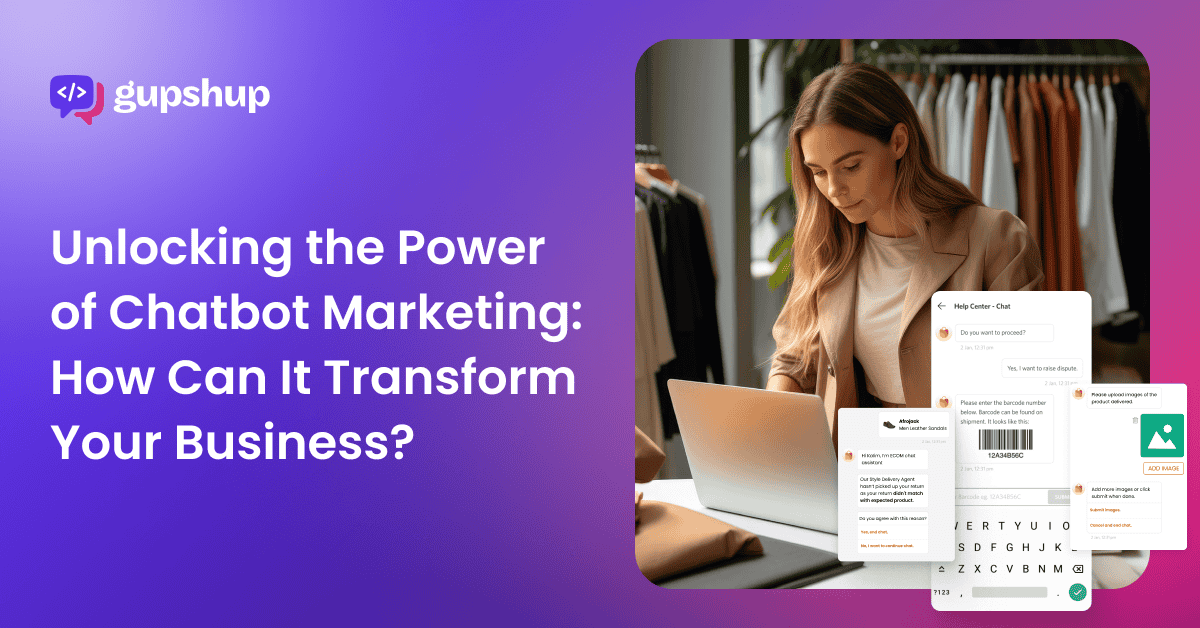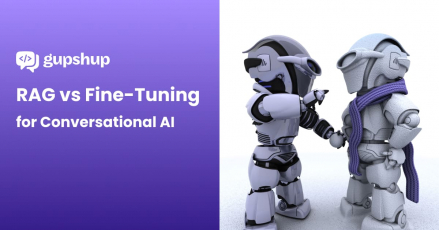Unlocking the Power of Chatbot Marketing: How Can It Transform Your Business?

Introduction
We are already on the verge of a business transformation where customer queries are answered instantly, sales conversations flow seamlessly, and marketing efforts feel less like a chore and more like delightful interactions.
This is how chatbot marketing is changing the game for businesses.
Global brands are leveraging AI-powered chatbots to connect instantly with customers, provide immediate support, and even drive sales across websites, social media, and messaging platforms. The impact is undeniable: a recent survey revealed that 26% of B2B companies using chatbots experienced a remarkable 10-20% increase in lead generation.
The reason? Customers crave instant responses, and AI-powered chatbots deliver precisely that, 24/7. These tireless digital assistants navigate websites, social media, and messaging apps, providing smooth, quick, and often engaging interactions, from recommending products to troubleshooting issues.
This is the future of conversational marketing—a dynamic approach that renders traditional methods increasingly outdated.
Discover how chatbot marketing can save your business time and resources while simultaneously enhancing customer support. In this blog, we will explore what chatbot marketing is, why it matters, and how it is shaping the future of customer engagement.

How Does Chatbot Marketing Work?

To understand how chatbot marketing works, let us start with an example of the conversational marketing funnel. Picture it as a pyramid guiding customers from when they are curious about your product to the step where they purchase it. This funnel has stages like awareness, interest, decision, and action. AI chatbots work like the connectors that make this conversational marketing funnel work smoother.
The technology that powers chatbots:
Behind the scenes, chatbots are equipped with Conversational AI, which is made of three main parts:
- Machine learning: This helps the AI chatbot get smarter. It learns from conversations and improves over time.
- Natural language processing: This is how the chatbot understands human language. If your customer asks ‘What is the price?’ or ‘How much does this cost?’, the bot will know they mean the same thing.
- AI algorithms: These help chatbots predict what the customer will ask next. For example, if someone types, ‘I need help choosing a gift’, the chatbot might reply, ‘Sure! Who’s it for? We’ve got great options for all occasions.’
- Generative AI and LLMs: Backed with advanced AI models, Generative AI can create human-like, context-aware, and personalized responses. It also helps with tasks like writing detailed product descriptions, summarising policies, or even storytelling, adding a creative touch to customer interactions.
- LLM: LLMs process vast amounts of text data, allowing chatbots to generate conversational and meaningful answers. For example, if a customer asks for gift ideas, the bot could suggest, ‘How about a handbag? They’re great for any occasion!’ Unlike traditional chatbots, these responses are not pre-programmed, but dynamically generated based on context.
Integration with platforms
Now that you know the technologies behind AI chatbots, learn where they work. Chatbots can integrate with:
- WhatsApp Business API
- Social media platforms like Facebook or Instagram.
- Websites, email, RCS, and SMS to act as your always-on assistant
Benefits of chatbot marketing
The root of chatbot marketing lies in customer engagement. The more you can meet your customers via their favorite social media apps or communication channels, the higher your chance of growing your business.
Below are some key benefits of using a chatbot to navigate your customer journey.
- Lead generation made easy:
Chatbots actively engage the customers who find you via a click-to-WhatsApp ad.
For example, when someone has a query, the chatbot collects their contact details and starts the conversation. Why is this important? Because every contact is a potential customer. Unlike traditional ads or email sign-ups that feel pushy, a chatbot’s interaction feels natural.
- Personalized user experience:
People love feeling special, and AI chatbots excel at that. If a customer is searching for a gift, instead of browsing hundreds of items, the chatbot asks for specifications of what kind of items they are looking for. If the customer says, ‘Birthday gifts for 10 years old’, the chatbot instantly shows the result that matches this request.
This level of personalization saves time and makes shopping easier. Moreover, customer satisfaction peaks which benefits into keeps them coming to your brand over and over again.
- More conversions, less hassle:
The goal of chatbot marketing is to turn your target audiences into paying customers. By providing quick answers, sharing product recommendations, or offering discounts at the right moment, they nudge customers closer to making a purchase.
For example, when someone is unsure about buying a product, the chatbot can look for a suitable discount and offer it during checkout. That little push often seals the deal.
- Cost efficiency
Traditional methods like cold calls or emails take time, money, and a big team. Chatbot marketing cut those costs significantly. They handle thousands of conversations at once, and you do not need a team to monitor them 24/7.
- Insights through data
Every conversation with a chatbot provides valuable information. What are customers asking for? When are they most active? What products interest them the most? This data helps you improve your marketing strategies and make better decisions.
Customer Journey- Marketing Applications of Chatbots
Among all chatbot applications, marketing is its third most-used advantage of it. Its functions are vast, covering almost every digital request put by your customers. Below, find some common usage of chatbot marketing essential for your customer’s journey:
Guiding, upselling, and discounting:
The e-commerce sector mainly guides customers through the last mile process and updates them on their purchased orders. Upselling customers new items based on their purchase history is another big reason e-commerce industries are booming.
Chatbot marketing not only improves their shopping experience but also boosts your revenue. Through customer engagement, it provides discounts, cross-sells, upsells, and gathers trust.
Collecting data and routing leads:
The sales and retail sector thrives on understanding what customers want and delivering it seamlessly. Conversational AI chatbots play a crucial role here by collecting data during interactions and directing potential buyers to the right products or teams.
For example, when a customer visits your retail website, the chatbot can guide and show them specific collections. If they’re undecided, the bot can suggest bestsellers or trending items. Moreover, it can route leads to the appropriate department. This ensures no lead is lost and every inquiry is handled efficiently.

Quick and reliable post-purchase support:
Customer satisfaction does not end at checkout. Post-purchase support is where you can turn buyers into loyal customers. Chatbots make this process quick and easy by handling common questions.
Conversational AI chatbots can also handle complaints or escalate issues to human agents when needed, ensuring every customer feels heard and supported. This not only saves time but also enhances the user experience.
Taking orders and segmenting users:
Taking orders is no longer limited to websites or apps. Chatbots can now handle the entire process right in the chat window.
They also help with user segmentation. By analyzing customer interactions, they can categorize users into groups like ‘frequent shoppers’, ‘new customers’, or ‘discount seekers’. This conversational messaging allows you to send personalized offers.

Product promotions and speeding up payments:
Promoting products and closing sales have never been easier. With chatbot marketing, you can send targeted messages about new launches, limited-time offers, or seasonal sales- all within the familiarity of WhatsApp.
Moreover, when it is time to pay, WhatsApp chatbots simplify the process. Instead of surfing through multiple pages, customers can complete their purchase directly through the chat. This reduces cart abandonment and ensures a seamless experience.

Metrics and KPIs for measuring chatbot success
To know if your chatbot marketing is working, you need to track the right metrics. These metrics give you a clear picture of how your chatbot is performing and where it can improve. Here are a few ways you can track it:

- Engagement metrics: Engagement is about how much time people spend talking to your chatbot and how deep the conversation goes. It also includes understanding their emotions during the chat. Tools like sentiment analysis can even tell if customers are happy, frustrated, or confused while interacting with the bot.
- Conversion rates: This measures how often chats turn into actions like a sale, booking, or lead capture. For example, if 100 people start a chat and 20 make a purchase, your chatbot has a 20% conversion rate. If conversions are low, it is a signal to refine your approach. In such cases, make your discount clearer or streamline the buying process.
- Customer Satisfaction scores (CSAT): CSAT measures how satisfied users feel after chatting with your bot. At the end of a conversation, the Conversational AI chatbot might ask, ‘Was this helpful? Rate your experience from 1 to 5’. If users consistently rate 4 or 5, your chatbot marketing is going well. If the scores are lower, it could mean the bot is not answering questions sufficiently or the tone feels robotic.
Summing Up
As we have seen, chatbots do more than just chat. They build connections, boost sales, and make experiences smoother. Their ability to provide instant support and personalized recommendations makes them a must-have in today’s fast-paced world.
But it is not only about automation we talk about. The key is balance. Chatbots should enhance interactions, not replace the human touch. When done right, they become a powerful marketing ally. If you ever need a little help there, let Gupshup be your guiding light. Our chatbot platform helps you build, strategize, and deploy Conversational AI chatbots without any code across multiple platforms with ease.
The future of chatbot marketing looks exciting, with advancements in AI and voice tech paving the way. If you are not using chatbots yet, it is time to start. Connect with us, stay connected, and let chatbots do the talking!
FAQ’s
1. Can I integrate chatbots with the existing systems?
Yes, chatbots can integrate with various platforms, such as CRMs, payment systems, and social media. You can easily streamline workflows and run the chatbots.
2. What is the cost of implementing a chatbot?
The cost depends on the chatbot’s complexity and scale. However, platforms like Gupshup help you make cost-effective no-code chatbots very easily.
3. Can chatbots handle multiple languages?
Yes, advanced chatbots can support multiple languages. This means your business can connect with a global customer base effectively.
4. Is chatbot marketing secure?
Chatbots can be designed with encryption and security features. It is safe to use, ensuring that sensitive customer data remains protected.





